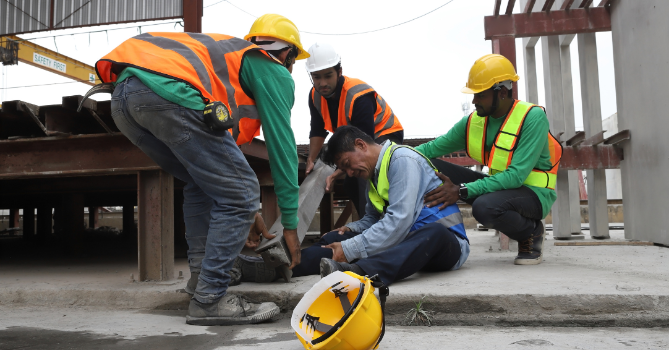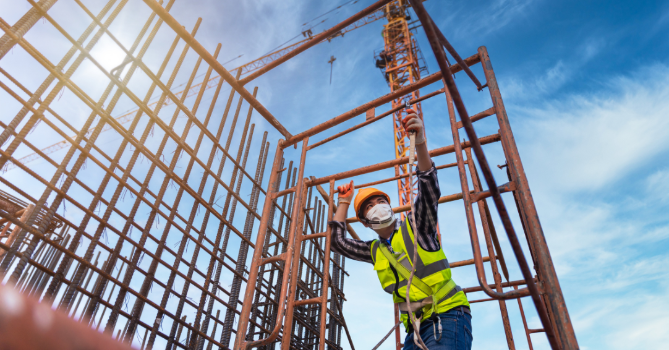.png)
Ensuring Safety on Construction Sites: Key Strategies and Investments
Ensuring safety on construction sites is crucial. Construction work is risky, and accidents can lead to severe injuries or even fatalities. Common incidents include falls, equipment mishandling, and exposure to harmful materials. These accidents not only harm workers but also cause project delays and increased costs.
Investing in safety measures is essential. Proper training, safety equipment, and regular inspections can prevent many accidents. Companies must prioritize the well-being of their workers by providing necessary safety gear and implementing strict safety protocols.
This blog will explore the importance of safety on construction sites, common hazards, effective safety practices, and the benefits of investing in safety. We will also discuss how to handle and prevent accidents. By adopting these measures, construction sites can become safer places for everyone involved.
Safety on construction sites is vital. Construction work is one of the most hazardous occupations. Accidents can result in severe injuries or even death. Falls, being struck by objects, and equipment mishandling are some of the most common incidents. According to OSHA, falls are the leading cause of fatalities in construction, accounting for about 33% of all deaths in the industry.
The impact of accidents extends beyond the injured worker. It affects the entire project. Accidents can cause delays, increase costs, and lead to legal issues. When a worker is injured, it can halt work, disrupt schedules, and require expensive medical treatments. Additionally, companies may face fines and increased insurance premiums.
Ensuring safety is not just a legal obligation but a moral one too. Employers have a duty to provide a safe working environment. This includes proper training, providing safety gear, and maintaining equipment. Workers should be trained to recognize hazards and know how to protect themselves. Personal protective equipment (PPE) like helmets, gloves, and safety harnesses are essential on construction sites. Regular inspections and maintenance of equipment can prevent malfunctions that might lead to accidents.
Investing in safety measures can save money in the long run. While the initial costs of training and equipment may seem high, they are far less than the costs associated with accidents. A safe site means fewer injuries, which means fewer delays and lower medical and legal costs.
In summary, construction site safety is crucial for protecting workers, maintaining project schedules, and controlling costs. By prioritizing safety, companies can create a safer work environment and ensure the well-being of their workers.
Construction sites are full of potential hazards. Understanding these risks is key to preventing accidents and ensuring worker safety.
Falls are the most common hazard. Workers often operate at heights, using ladders, scaffolds, and roofs. Without proper fall protection, such as harnesses and guardrails, the risk of serious injury or death is high. OSHA reports that falls account for one-third of all construction fatalities.
Struck-by incidents are another major concern. This can happen when workers are hit by vehicles, falling objects, or equipment. Wearing hard hats and maintaining awareness of surroundings can reduce these risks. Proper training and site management are crucial to preventing such accidents.
Caught-in between hazards involve workers getting trapped between machinery or collapsing structures. Trenches and excavations are particularly dangerous if not properly shored. Ensuring safe trenching practices and regularly inspecting equipment can mitigate these risks.
Electrical hazards are also prevalent. Live wires, faulty equipment, and improper use of extension cords can lead to shocks or electrocution. It's essential to de-energize circuits and use ground-fault circuit interrupters (GFCIs) to protect workers from electrical hazards.
Hazardous materials pose significant health risks. Exposure to asbestos, lead, and chemicals can cause long-term health problems. Proper handling, storage, and use of personal protective equipment (PPE) can minimize exposure.
Noise and vibration from heavy machinery can lead to hearing loss or other health issues. Providing ear protection and limiting exposure times are important preventive measures.
In summary, common hazards on construction sites include falls, struck-by incidents, caught-in/between accidents, electrical hazards, hazardous materials, and noise. Recognizing and mitigating these risks through proper training, equipment, and safety protocols is essential for a safer work environment.

Effective safety measures are essential for protecting workers on construction sites. Here are some key practices that can significantly reduce risks and improve safety:
1. Proper Training: Comprehensive training is crucial. Workers should be educated on recognizing hazards, using equipment safely, and following safety protocols. Regular refresher courses can keep safety knowledge current.
2. Use of Personal Protective Equipment (PPE): PPE like helmets, gloves, safety goggles, and harnesses are vital. Ensuring that all workers have access to and properly use PPE can prevent many common injuries. For example, helmets protect against head injuries from falling objects, while harnesses prevent falls from heights.
3. Regular Site Inspections: Frequent inspections help identify and address potential hazards before they cause accidents. This includes checking scaffolds, ladders, and machinery for defects, and ensuring that safety measures are in place and functioning.
4. Safety Protocols and Procedures: Clear, well-communicated safety procedures are essential. This includes having an emergency response plan, proper signage, and clear communication channels. Workers should know what to do in case of an accident and how to report hazards.
5. Equipment Maintenance: Regular maintenance and inspections of tools and machinery prevent malfunctions that can lead to accidents. Ensuring that all equipment is in good working order and safe to use is critica.
6. Fall Protection Systems: Given that falls are a leading cause of injury, fall protection systems like guardrails, safety nets, and personal fall arrest systems are crucial. Workers should be trained in using these systems properly.
7. Site Cleanliness and Organization: A clean and organized site reduces the risk of trips, slips, and falls. Keeping walkways clear of debris, securing loose materials, and ensuring proper storage of tools and equipment are simple but effective practices.
8. Communication and Reporting: Encouraging a culture of safety where workers feel comfortable reporting hazards without fear of retaliation is vital. Regular safety meetings and open communication can help address issues promptly and prevent accidents.
By implementing these safety measures, construction sites can become much safer, protecting workers and reducing the risk of accidents. These practices not only save lives but also improve productivity and reduce costs related to injuries and delays.
Investing in safety on construction sites is crucial. These investments not only protect workers but also save money in the long run. Here are key areas where investments can make a significant impact:
1. Safety Equipment: Investing in high-quality personal protective equipment (PPE) such as helmets, gloves, safety goggles, and harnesses is essential. Proper PPE reduces the risk of injuries and fatalities. For example, safety harnesses and guardrails can prevent falls, the leading cause of construction site fatalities.
2. Advanced Technology: Modern technology plays a crucial role in enhancing safety. Building Information Modeling (BIM) allows for detailed planning and risk assessment. Drones can be used for site inspections, reducing the need for workers to enter hazardous areas. Wearable technology, such as smart helmets, can monitor worker health and environmental conditions in real-time.
3. Training Programs: Regular and comprehensive safety training for all workers is a must. Training programs should cover hazard recognition, proper equipment use, and emergency procedures. Investing in continuous education ensures that workers are up-to-date with the latest safety practices and protocols.
4. Maintenance and Inspections: Regular maintenance of equipment and thorough site inspections are essential. Investing in routine checks helps identify potential issues before they become serious problems. Well-maintained equipment is less likely to fail and cause accidents.
5. Emergency Response Systems: Having a robust emergency response system in place is critical. This includes first aid training, emergency drills, and readily available medical supplies. Quick and efficient responses to accidents can save lives and reduce the severity of injuries.
6. Safety Management Software: Implementing safety management software can streamline safety protocols and reporting. These systems help track safety performance, manage compliance, and ensure that safety measures are consistently applied across the site.
Investing in these areas not only improves safety but also boosts productivity and morale, and reduces costs associated with accidents and downtime. By prioritizing safety investments, construction companies can create a safer and more efficient work environment.

Handling and preventing accidents on construction sites is essential for safety. Here are key steps to manage and prevent accidents effectively:
1. Emergency Response Plans: Every construction site should have a clear emergency response plan. This includes detailed procedures for different types of emergencies, such as fires, falls, or equipment malfunctions. Workers should know how to respond quickly and efficiently to minimize harm.
2. First Aid Training: All workers should receive basic first aid training. This prepares them to handle minor injuries and provide initial care before professional medical help arrives. Having well-stocked first aid kits readily available on-site is also crucial.
3. Accident Reporting: Prompt and accurate reporting of accidents is vital. This helps identify the cause and prevent similar incidents in the future. Encourage workers to report all incidents, no matter how minor, without fear of reprisal.
4. Regular Safety Drills: Conduct regular safety drills to ensure everyone knows how to react in an emergency. Drills help familiarize workers with evacuation routes and emergency procedures, improving their response times during real incidents.
5. Continuous Safety Education: Ongoing safety education keeps workers informed about the latest safety protocols and best practices. Regular training sessions and safety meetings can reinforce the importance of following safety guidelines.
6. Proactive Safety Measures: Implement proactive measures to prevent accidents. This includes maintaining clean and organized work areas, ensuring proper use of PPE, and conducting regular equipment inspections. Identifying and mitigating potential hazards before they cause harm is the best way to prevent accidents.
By focusing on these steps, construction sites can handle and prevent accidents more effectively, ensuring a safer environment for all workers.
Ensuring safety on construction sites is crucial for protecting workers and maintaining efficient project timelines. By investing in proper training, safety equipment, and advanced technologies, companies can significantly reduce risks and prevent accidents. Regular site inspections, clear safety protocols, and proactive measures are essential for creating a safe work environment. Addressing and preventing accidents through emergency response plans and continuous education further reinforces a culture of safety. Prioritizing safety not only saves lives but also enhances productivity and reduces costs associated with injuries and delays. A committed approach to safety ensures a better, safer future for the construction industry.